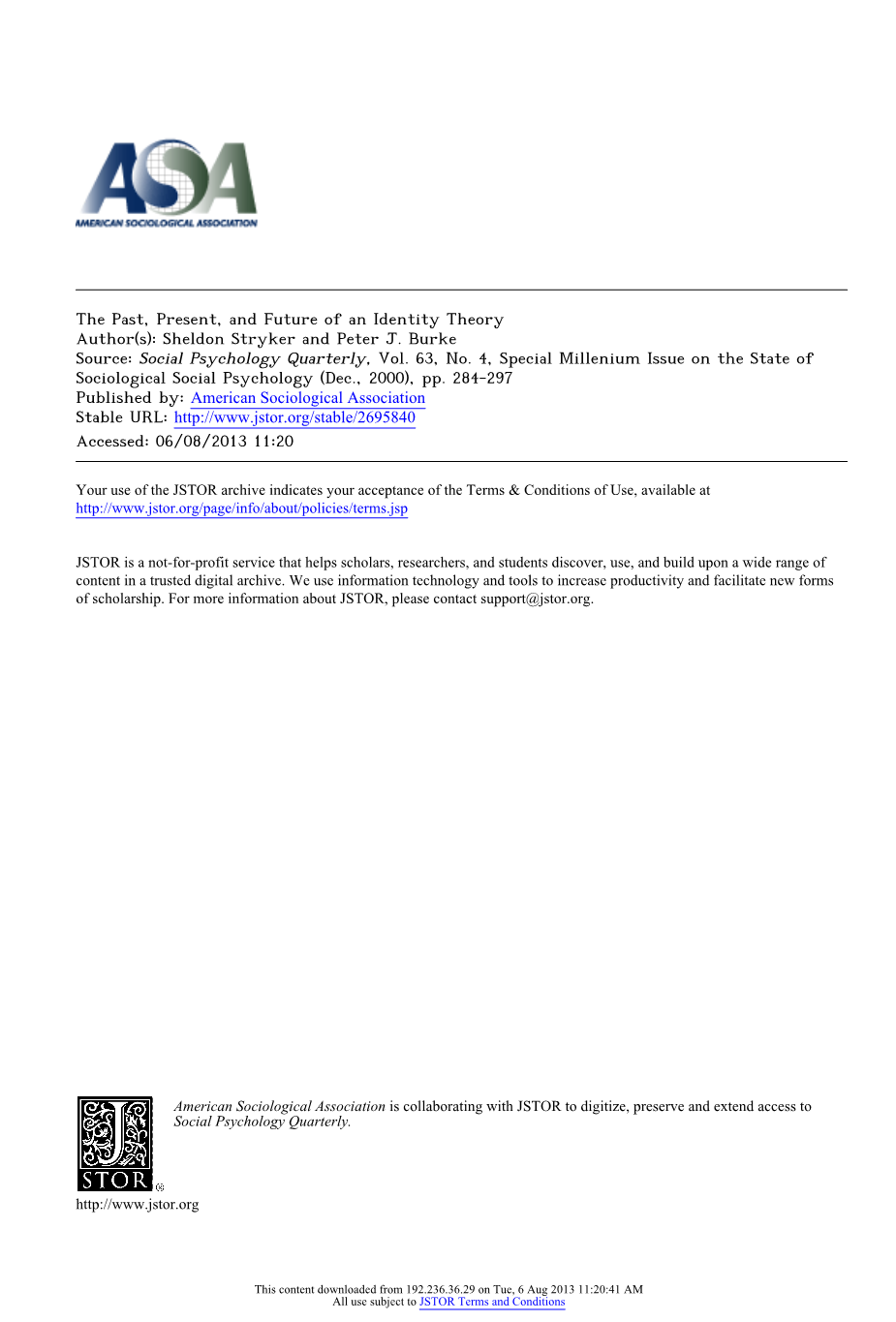

英语原文共 15 页,剩余内容已隐藏,支付完成后下载完整资料
身份理论的过去、现在和未来
目 录
External social structure and the structure of self 4
英文原文
The Past, Present, and Future of an Identity Theory(节选)
Introduction
Among the many traditions of research on 'identity,' two somewhat different yet strongly related strands of identity theory have developed. The first, reflected in the work of Stryker and colleagues, focuses on the linkages of social structures with identities. The second, reflected in the work of Burke and colleagues, focuses on the internal process of self-verification. In the present paper we review each of these strands and then discuss ways in which the two relate to and complement one another Each pro- vides a context for the other: the relation of social structures to identities influences the process of self-verification, while the process of self-verification creates and sustains social structures. The paper concludes with examples of potentially useful applications of identity theory to other arenas of social psychology, and with a discussion of challenges that identity theory must meet to provide a clear understanding of the relation between self and society.
The language of 'identity' is ubiquitous in contemporary social science, cutting across psychoanalysis, psychology, political science, sociology, and history. The common usage of the term identity, however, belies the considerable variability in both its conceptual meanings and its theoretical role. Even when consideration is restricted to sociology and social psychology, variation is still considerable.
Three relatively distinct usages exist. Some use identity to refer essentially to the culture of a people; indeed they draw no distinction between identity and, for example, ethnicity (see the collected papers in Calhoun 1994). Thus they obscure the theoretical purpose of its introduction. Others use identity to refer to common identification with a collectivity or social category, as in social identity theory (Tajfel 1982) or in contemporary work on social movements, thus creating a common culture among participants (Snow and Oliver 1995). Finally, some use the term, as we do in the work underlying this paper, with reference to parts of a self composed of the meanings that persons attach to the multiple roles they typically play in highly differentiated contemporary societies.
This last usage, of course, is not unique to our prior work. In some ways, it is shared by all who claim Mead (1934) and symbolic interactionism as important to their intellectual heritage, and who recognize the complexity of contemporary social life; those who take a situated identity perspective are a case in point (e.g., Alexander and Wiley 1981). McCall and Simmons (1966) develop ideas closely related to the earliest published presentation (Stryker 1968) of the ideas basic to this paper,2 yet different in more than nuance and in approach to theory development. Specifically, the frame within which identity is conceptualized here is shared (for example) by affect control theorists and researchers (Heise 1977, 1979; MacKinnon 1994; Smith-Lovin and Heise 1988) who are motivated by theoretical problems related but not identical to those underlying the present paper,and by students of multiple roles and identities and their consequences(e.g.,Reitzes and Mutran 1995;Thoits 1983;Wiley 1991).
We limit our attention here to the strand of theorizing and research represented by, and developing from, our earlier work. Since 1966, this work has appeared under the label identity theory; in the rest of this paper we retain that usage to simplify presentation.
Identity theory has evolved in two somewhat different but closely related directions. Both are instantiations of a theoretical and research program labeled structural symbolic interactionism (Stryker 1980), whose goal is to understand and explain how social structures affect self and how self affects social behaviors. The first aspect, however, concentrates on examining how social structures affect the structure of self and how structure of the self influences social behavior, whereas the second concentrates on the internal dynamics of self-processes as these affect social behavior. Thus, relatively speaking, the first neglects internal dynamics of self- processes, while the second neglects ways in which external social structures impinge on the internal processes. The first is represented by work of Stryker and colleagues (e.g., Stryker 1980; Stryker and Serpe 1982), the second by work of Burke and colleagues (e.g., Burke 1991; Burke and Reitzes 1991; Burke and Stets 1999). By explicitly articulating the relation between these two bodies of work, we can refine and expand the scope of the structural symbolic interactionist frame and suggest new applications of the frame and derivative theories. The present paper is directed to these purposes.
External social structure and the structure of self
Identity theory traces its roots to the writings of George Herbert Mead (especially 1934) which present a framework underwriting the analyses of
剩余内容已隐藏,支付完成后下载完整资料
资料编号:[254337],资料为PDF文档或Word文档,PDF文档可免费转换为Word
您可能感兴趣的文章
- 通过在消费者心中树立品牌关系导向来提高酒店品牌绩效外文翻译资料
- “友好“抱怨行为:走向亲密的手段外文翻译资料
- 服务蓝图:针对关键服务流程的有效方法-在四星级国际酒店Arash Shahin 管理部进行案例研究外文翻译资料
- 组织中女性高管职业生涯规划与晋升的视角:连锁性别偏见的经验,双重束缚,和不成文的晋升规则外文翻译资料
- 影响优秀员工工作满意度的激励因素识别外文翻译资料
- 探索离职意向的影响因素:以豪华酒店员工为例外文翻译资料
- 新冠肺炎疫情下,中国酒店旅游业面临的挑战与机遇外文翻译资料
- 酒店Twitter账号的营销效果:以沙特阿拉伯为例外文翻译资料
- 酒店旅游市场营销外文翻译资料
- 中国经济型酒店SWOT分析外文翻译资料


